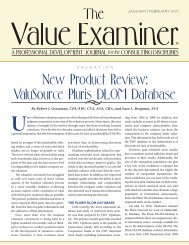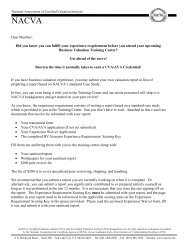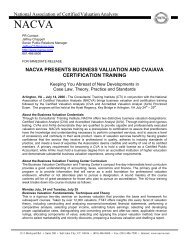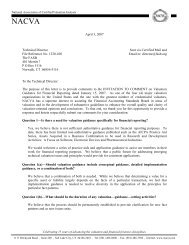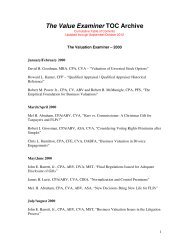VALUATION DISCOUNTS AND PREMIUMS
VALUATION DISCOUNTS AND PREMIUMS
VALUATION DISCOUNTS AND PREMIUMS
You also want an ePaper? Increase the reach of your titles
YUMPU automatically turns print PDFs into web optimized ePapers that Google loves.
Fundamentals, Techniques & Theory<strong>VALUATION</strong> <strong>DISCOUNTS</strong> <strong>AND</strong> <strong>PREMIUMS</strong>B. <strong>DISCOUNTS</strong> <strong>AND</strong> <strong>PREMIUMS</strong>/ FUNDAMENTAL CONCEPTSThe fair market value of a business interest is determined by transactions between buyers andsellers. Ultimate estimation of fair market value under commonly accepted valuationapproaches and methodologies requires the business valuator to identify and consider thoseownership interest characteristics that are specific to the interest being valued.Investors are risk averse. Ownership interest attributes that increase the risk of holding theinvestment will inherently depress the value of the ownership interest. Likewise, those specificcharacteristics that serve to diminish investment risk will increase that ownership interest’svalue.The propriety of any discount or premium is undeterminable until the base to which theadjustments are applied is clearly defined. Utilization of discounts and premiums cannotproduce a correct result if applied to an inappropriate base conclusion of value.No “prescribed” levels or ranges of discounts or premiums exist from which the valuator canascertain the proper adjustments for a specific case. Moreover, the valuator cannot expect touse a common set of computations or formulas to determine the appropriate adjustments in jobswith differing facts and circumstances.Though not totally mutually exclusive concepts, the discount for a lack of ownership control(minority) and the discount for lack of marketability are generally held to be separate anddistinct. While it is true that some crossover exists whereby a non-controlling interest is lessmarketable than a controlling interest by virtue of the non-control feature, sufficient third partyinformation exists to support separation of the two. Otherwise, insurmountable difficulties arisein determining a proper level of combined discount.Practice pointerIn those instances where the business valuator deems it appropriate to apply both a discount forlack of ownership control and a discount for the lack of marketability, the application of thediscounts is multiplicative, not additive.The discount for lack of ownership control is generally applied first, principally due to thecommon understanding that both control and minority ownership interests may be subject to adiscount for a lack of marketability. Moreover, the only empirical data for lack of marketabilityis available at the minority interest level, further supporting the concept of applying theminority discount first.Due to specific characteristics requiring the application of discounts for both a lack of controland a lack of marketability, minority ownership interests in privately held businesses may beworth much less than their proportionate share of the overall business value. In other words, thesum of the parts may not add up to the whole.© 1995–2012 by National Association of Certified Valuators and Analysts (NACVA). All rights reserved. Chapter Seven – 3Used by Institute of Business Appraisers with permission of NACVA for limited purpose of collaborative training. 2012.v1



